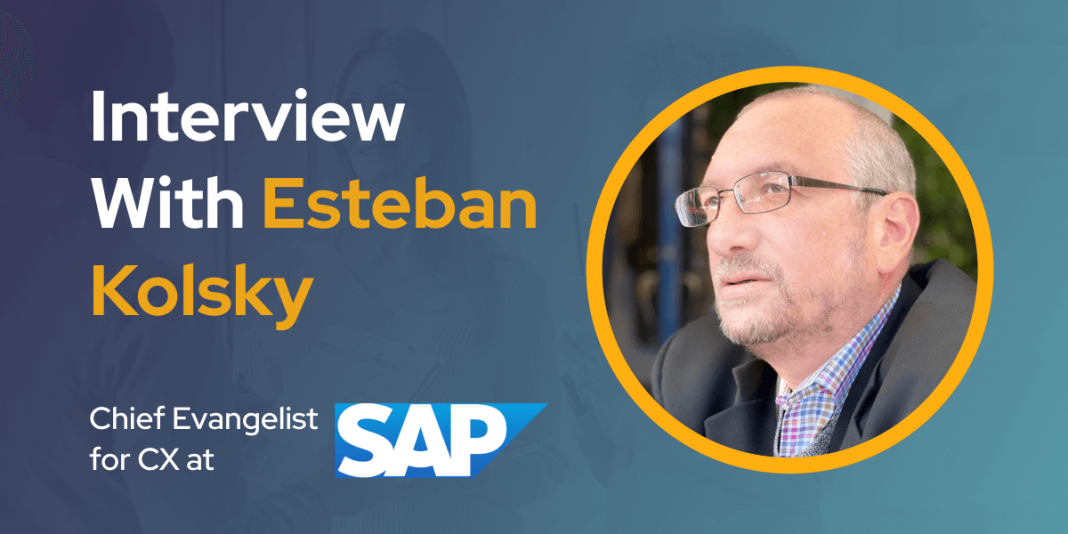Hi Esteban, tell us about yourself and share some background about the SAP Customer Experience (and how you ended up joining SAP)
I am the Chief Evangelist for CX at SAP. I have been doing CX (and CRM prior) since the early days. I implemented one of the first Siebel solutions in 1997-1999, following a 10+ years career working in customer service. After that, I became an analyst at Gartner where I was partly responsible for the focus on customer experience management, enterprise feedback management, and similar topics that later became the basis for the current field of CX. I concluded my analyst work, post-Gartner, being an independent analyst focused on helping vendors with their product strategies.
During this time, I worked with Bob Stutz in different manners, which led to him asking me to help him when he came back to SAP as head of Engineering & Operations for SAP CX in 2019. I always admired the possibilities that SAP had in the CX space but was frustrated with the lack of results. As they say, you can either complain or do something about it. I joined SAP in December 2019 to work on improving the market outcomes for a great set of products.
Online commerce was booming in 2020; how did it affect the enterprise software space? – What should be the main focus for brands this year?
Online commerce exploded in 2020 by necessity, not planning. Thankfully we were sufficiently advanced in cloud adoption in the enterprise, and eCommerce features and solutions, to be able to power this need. Can you imagine what would’ve happened if the pandemic would’ve happened 20 years ago with no ability to work remotely?
Brands recognized there was a certain element of luck in the “preparations” leading up to the pandemic and recognized the good fortune of being able to shift their models quickly and respond to their customers’ needs. But they also realize they need better than a knee-jerk reaction solution (in most cases, a few were already on their way to becoming digital powerhouses and adapted their timelines, but the majority were caught off guard) and have already started the process of proper “planning and strategizing.”
While “changing a tire while driving 100 mph down the freeway” is not the preferred mode of doing it, we were lucky. In this post-pandemic world, the emphasis has changed from how to do it to how to do it well. Virtually all the conversations I am having with executives these days point to the need to plan longer-term what we did in short spurts during 2020. You will see brands continue to strengthen their “field-deployed” solutions for commerce and begin the serious work of integrating end-to-end their solutions as they had for previous systems.
The consumer sentiments changed a lot in the tech space during 2020, how is 2021 going to look like in your POV?
Actually, when it comes down to what the sentiment is – consumer sentiment towards brands did not change a lot. Expectations continue to be the same as they were: know me, understand me, personalize my interactions, learn more about me, rinse and repeat. This has remained the constant.
However, consumer sentiment has expanded to incorporate empathy and humanity as part of the expectations for brands. In spite of the many brands who had been advocating for this over the years, we needed a catalyst event to make the shift more permanent. I am not sure if this change will remain long-term – but it is a welcome change in the short term.
Brands are responding by making sure their empathy and approach to social issues is front and center and began to align that with delivery to customers. While still mostly in the messaging stage, we are seeing socially responsible brands like Patagonia take a leadership position in showing the rest of the brands how social responsibility and empathy work.
Esteban’s checklist for CX strategy
In your POV, what is the ultimate checklist for a good customer experience strategy?
There is only item in the checklist, to be honest.
A good customer experience strategy is the recognition that customers own their experiences, and brands only play a supporting role in them.
Any brand that can recognize this and begin to act accordingly – by stopping trying to force experiences to customers, and instead of working on understanding them better, preparing a better technology and process framework from where customers can build their experiences as they need them, and using lessons learned to optimize going forward – will be well regarded by consumers and customers.
Technology is not very important in understanding this concept, but a well-established technology platform leading to an open ecosystem is critical during the delivery of this model across channels, situations, places, and people. With an end result of an accurate resolution anywhere, anytime, and with a personalized, optimized process – brands need to understand the shift of control from them to the customer.
What makes SAP customer experience different from your direct competitors? And how is it different than other players in your space?
I am trying to expand the conversation without a deep focus on products.
We have a winning plan, we have the right to win in specific situations, and we have fantastic clients who totally trust our leadership in this space without worrying about details of specific features and functions. We have great, very competitive and award-winning products. I came here because the opportunity was too big, and I saw a need to expand the focus on CX, not the technology.
I became an evangelist to grow those conversations without relying on the product as a crutch.
Our main focus is ensuring our clients can fulfill the business outcomes dictated by their customers, and our product design guidelines follow that model. Technology is not the answer for CX, which is why we need ample conversations about what CX is, how to make the brand more powerful within those models, and what should the results be.
What was the biggest lesson you learned in 2020?
Three most important things: an executive level in the airlines/hotels/car rental companies do not help much when you’re stuck at home. There is no room service at home. And yes, it is ok not to be on the road constantly.
In all seriousness, and related to this article, the biggest lesson is the resiliency of most businesses and the ability to adapt to impossible situations and become successful quickly and effectively by leveraging technology in the support of business plans. If you really think about what we accomplished globally in 2020 (and ongoing) thanks to technology, its remarkable.
2020 was the year of webinars and online events, what was your favorite one?
Having spent 20 years in the conference circuit prior to this, I can honestly say none. And as a frequent presenter myself, I hated (and continue to) doing it in front of a computer only. The personal touch, the engagement from the stage, the interaction with attendants afterward, serendipitous run-ins in the hallways – those were the true values of conferences that we don’t have now.
The ability to find all the content and information needed in far shorter times, that’s the value of online. It takes me 2-4 hours versus 4 days sometimes to do a conference with what I need.
It looks like working from home is going to stay with us for the foreseeable future, how should Executives gear up to the changing times?
Working at home (different from working from home) is the model that was thrown at people in March of 2020 and found most of them without the necessary technology setup, routines, and even ability to do it amidst kids and other responsibilities. The resiliency of the human spirit turned work-at-home into work-from-home throughout 2020 and you’re correct, we won’t see a return to the office for what’s likely a majority of people. Further entrenchment of working-from-home models will require executives to invest in different solutions o support people who are not going back to the office.
However, this is not going to be a binary solution. I worked from home for 23 years prior to the pandemic and I can tell you that face-to-face cannot be replaced anytime. Humans need other humans to solve complex problems, and these require an office setup and a closeness that online tools cannot provide. Retooling organizations to these two realities remain a critical worry point for executives in 2021.
Last but not least, what is your favorite CX metric?
The one that aligns better with each company’s strategic needs. All others that are thrown as “the one” are not if they cannot be aligned with KPI and adopted throughout the corporation. Net promoter score (NPS) being the most controversial one, but that’s fodder for a different discussion.






